
Part of running an efficient and organized business is making full use of the technology and resources available to you. It’s great to set up systems and processes and have them work for you, but in order to fully automate your business you also need to know which technologies are going to work best to support you in that.
Over the years I have worked with many different automation tools (either in my own business or for my clients) that have helped to support an online solo business owner, and today I’d like to share my top five favorite ones with you. All of these tools I use in my own business today – and they’re a huge timesaver as well as creating a more streamlined and automated business for me.
1. 1ShoppingCart – this is my shopping cart, autoresponder, broadcast, and database management systems all rolled into ONE system. I especially like this service because everything is done in one place which really does make for a more streamlined business. It is possible to use one service for your shopping cart activities (i.e. product sales) and another service for your autoresponder/broadcast (i.e. sending out your newsletter) but the danger with this is that you are running two different databases and at some point it will become cumbersome and may even start to become unmanageable.
2. TimeDriver – this is probably my favorite find and is such a huge timesaver for me; I’m so grateful to one of my clients for putting me onto this service. It’s a system whereby you can get your clients to self-schedule their appointments with you, avoiding the back and forth of emails that happens when you’re trying to arrangement appointments and, of course, the time spent doing this. You simply give your clients/colleagues the special link that’s generated by TimeDriver and they are able to see your availability (which you have pre-determined) and therefore schedule accordingly with you. It works with both Outlook and Google calendars.
3. Submit Your Article – this service is an article submission service (notice I said ‘service’ not ‘software’) that submits your articles to hundreds of different article directories and ezine publishers on your behalf. You simply upload your article to your account and they do the rest. It’s a really great way of getting your articles out to a lot of places in the shortest amount of time possible, and again is another huge timesaver.
4. BYOAudio – as well as using this service to record and host all my teleclass audios, I make full use of their Podcast feature. You can record your podcast episode directly into your podcast, and they will share and syndicate it with the top podcast directories – even iTunes – immediately it’s published! Those directories, in turn, come and get your podcast, index it, and make it available to their visitors. All this takes is about 10/15 minutes of my time to record my podcast episode and publish it to my podcast. Another great strategy for building my list that really takes no time at all to implement!
5. OnlyWire – this is the service I use to create social bookmarks for my blog entries – they even post to Twitter and Facebook. Social bookmarking is a method for Internet users to store, organize, search, and manage bookmarks of web pages. It works in two ways: i) When someone stores a bookmark to one of your blog posts they have an easy way to access your information again; and ii) because these bookmarks are stored on the website’s of the social bookmarking sites, i.e. Technorati, Digg, etc. etc. they provide backlinks to your blog/website. If you wanted your bookmarks to appear on each of these social bookmarking sites you could do it all manually, i.e. create an account, log in to your account, post your bookmark, and repeat this process for every social bookmarking site you have an account at. Where OnlyWire comes in is that you provide your account login details at the various social bookmarking sites, submit your blog post URL for bookmarking, and OnlyWire will do the publishing for you! One or two clicks and you’re done!


